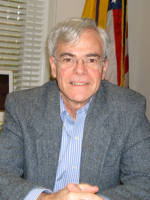
| TH E N I H C A T A L Y S T | JU L Y – A U G U S T 2008 |
| | |
 |
DDIR Michael Gottesman |
A great deal of activity has taken place at the NIH over the past two years related to defining and developing grass-roots scientific projects that could draw resources and talent from all of the NIH Institutes and Centers. In the Office of Intramural Research, these activities have been facilitated by Paul Liu, Genetics and Molecular Biology Branch, NHGRI; Crystal Mackall, CCR NCI; and Charles Dearolf, Assistant Director, OIR. This is a progress report on some of these activities.
A one-day conference convened by Neal Young, Director of the Center for Human Immunology (CHI), and the CHI Executive Committee and Scientific Advisory Board, was held on June 23, 2008, to obtain input from outside experts on scientific themes and organizational structures for the CHI, to present the existing vision of the CHI to the general NIH intramural community, and to assess the level of interest among intramural investigators to participate. The major scientific theme that came out from the conference is a high-throughput and high-content description of the human immune system in health and disease. It is envisioned that an atlas of human immune system, or "immunome," will be generated, which can serve as the reference standard for basic and clinical studies of many diseases with immunologic components.
One important initial goal is to establish robust multidimensional platforms for large-scale data collection. Such platforms, once established, will serve as the basis for collaborations throughout the NIH campus on investigator-initiated projects relevant to human immunology. Space has been assigned to the CHI on the 7th floor of Building 10 and funding has been obtained from the OD and several ICs to establish the Center and fund it for at least the next five years.
A new trans-NIH project under development, the Bone Marrow Stromal Cell Transplantation Center (BMSCTC), would establish cell processing procedures to develop clinical-grade human bone marrow stem cells (BMSCs) for the treatment of patients with skeletal and non-skeletal diseases and disorders. Rapidly adherent BMSCs contain a subset of stem cells capable of regenerating bone, cartilage, myelosupportive stroma and adipocytes. BMSCs can be expanded ex vivo while maintaining their multi-potentiality and have been used in pre-clinical studies for bone regeneration. BMSCs have been proposed for treatment of non-skeletal conditions, as an immunosuppressive reagent, and as an adjuvant for hematopoietic stem cell transplantation. Thus, BMSCs are an easily accessible source of cells that can be used for a wide range of conditions.
A large number of investigators from 13 ICs have expressed interest in using BMSCs. The BMSCTC has been identified as one of the two "Manhattan Projects" by the IC Directors for further consideration. Establishment of this Center would entail the use of the NIH CC Department of Transfusion Medicine to expand BMSCs for clinical protocols initiated by investigators from all institutes. Look for an upcoming Catalyst article about the people involved and science planned at this Center.
The Systems Biology initiative sponsored two significant workshops. On May 12, six intramural scientists presented talks at a systems biology workshop designed to inform the community about ongoing research here at NIH. On June 26–27, the initiative sponsored a second workshop, "Computing the Future: Systems Biology and the NIH." A number of extramural scientists presented talks, then discussed with NIH leaders productive directions the NIH program could take. Afterwards, there was a recommendation that a Systems Biology Center should focus on the biological issue of mouse and human tissue-specific functional genomics and cellular reprogramming. This research will span the interests of a range of ICs, and will include studies into normal networks, disease networks, and cellular therapies.
The Systems Biology initiative, together with several intramural scientists and Scientific Directors, strongly endorsed the development of an RNA interference (RNAi) facility. RNAi is a powerful tool that allows investigators to determine the functions of genes systematically and in a relatively unbiased manner. The facility will provide intramural researchers with access to high quality, full genome RNAi screening in mammalian cells, as well as the necessary bioinformatics support. The facility will be housed at the NIH Chemical Genomics Center. NCI is taking the lead in funding the facility, with additional support from the OIR Director's Challenge Awards and from other ICs.
The NIH Director's Challenge Awards, previously described in The Catalyst, provided $500,000 to fund six investigator-initiated projects recommended by the Trans-NIH Imaging Initiative. Last November, the Imaging Initiative announced an NIH-wide call for proposals, requesting applications that would promote novel, interdisciplinary scientific collaborations that involve the development and application of new methodologies and approaches. The winning proposals include projects to develop a Cryo-PhotoActivation Localization Microscope, label-free imaging of biochemical processes in live cells and viruses using high-definition infrared micro-spectroscopy, and the development of a novel method for monitoring gene expression by magnetic resonance imaging.
I want to remind you that the OIR will expand the Director's Challenge Award program in FY2009. This fall, we will solicit ideas from senior and tenure-track investigators for exciting topics that deserve additional support. We will select several, then issue a call for proposals that both relate to one of the topics and bring together investigators from multiple ICs. Successful projects can receive two years of support for up to $250,000 per year.
-Michael Gottesman, DDIR
with Paul Liu and Charles Dearolf
 |
 |
|
Paul Liu |
Charles Dearolf |